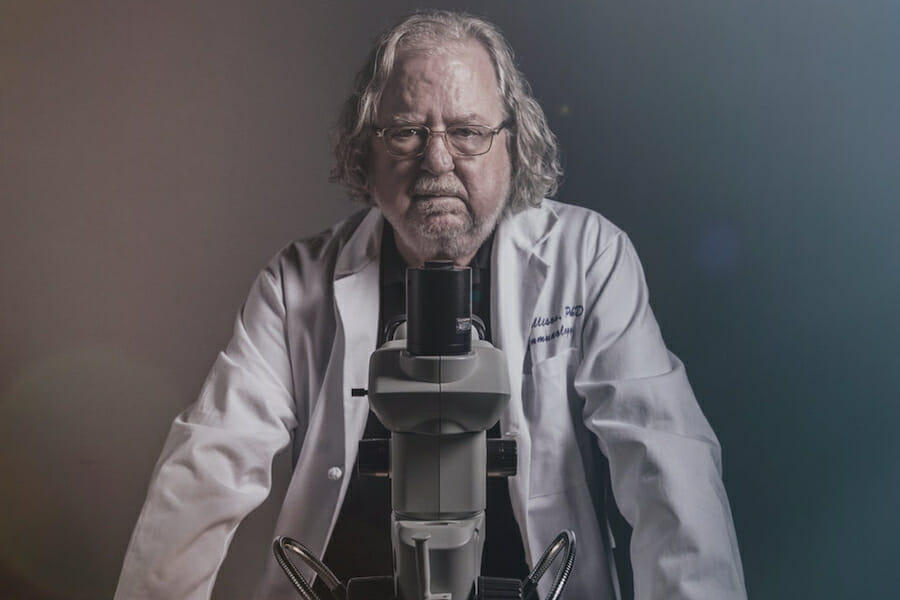
‘Jim Allison: Breakthrough’ Review
We don’t hear much about renegade scientists, at least not outside of science-fiction novels. It seems Jim Allison, the subject of this documentary, proudly embraces the label in real life. Many can thank him and his research and his hard-headedness for their being alive and cancer-free today.
Allison’s family hails from a quiet little, mostly Latino, south Texas town named Alice. He traces his Alice family roots to 1840, and his ancestors experienced the oil boom, agricultural advances, and the subsequent busts. His father later moved Jim, his two brothers and their mother to Dallas, which is where she died when he was 11 years old. Only near the end did Jim learn she had been suffering with lymphoma. Thus began his lifelong quest to cure the disease that killed his mother (and later his brother), and sent his dad into such a depressive state that Jim had to be raised by others.
In regards to the aforementioned hard-headedness, Jim’s brother discloses that, from an early age, they called him “diamond head,” a description that is quite self-explanatory. Much of the film takes us through Jim’s timeline. He studied Biology at UT Austin in 1965, ultimately earning his Ph.D. in 1973. It’s also where he met his wife Malinda, forming a couple that somehow worked despite his obsession with research and dalliances with music after hours. That’s right, Jim is a self-taught harmonica player who rarely misses a chance to play on stage in a club. There is even a clip of him performing with Willie Nelson at Austin City Limits. The infusion of Jim’s personal life helps balance the heavy dose of science served up – a necessary by-product of profiling a genius immunologist.
The film tracks Jim as a researcher at the Scripps Clinic in San Diego in 1974, and then as he was lured back to Texas in 1977 when MD Anderson opened a lab in Smithville, not far from Austin. He worked there until 1985, when UC Berkeley offered him a full professorship at a time when Immunology was still considered a quasi-science. We learn that it was really Jim’s research and work over many years that not only resulted in advancements in cancer treatment, but also the acceptance of Immunology within the scientific community.
Bill Haney is not your typical documentarian. He is Harvard educated, a successful inventor and entrepreneur, who has founded businesses and non-profits. Mr. Haney seems focused on making the world a better place, and he recognizes that a man like Jim Allison deserves to have his story told…in fact, he deserves to be a household name. As a filmmaker, Mr. Haney understands that we connect best with personal stories. He introduces us to Sharon Belvin who was diagnosed with melanoma at age 22. Sharon tells her story and how none of the traditional chemotherapy treatments were working for her, and it wasn’t until she became part of the trial for Allison’s approach that she saw improvement. Hers is a fascinating case study, and that one that resonates with us because she is so personable and likable.
We are informed that various types of cancer kill up to 9 million people each year. Two reporters, Eric Benson from Texas Monthly and Andrew Pollack from The New York Times fill in the story with some of the industry progressions. There is even an attempt at simplifying T-Cells, T-Cell receptors, and CTLA-4 for us non-science folks. The importance of Bristol-Myers Squibb and their patents is discussed, and we gain insight from Allison’s best friend and professional associate, Lewis Lanier. All of this helps us understand the challenging path Allison chose to pursue his work.
The descriptions of him as a passionate and creative scientist may contrast with our predisposed impressions of scientists, but by the end, we understand why Jim Allison was awarded the Nobel Prize for Medicine in 2018. His Ipilimumab and its follow-up Immuno-Oncology have saved hundreds of thousands of lives. Director Haney’s choice of Woody Harrelson as a narrator for a science film deserves to be questioned, but his choice of Jim Allison as a man whose work deserves to be recognized, and whose name should be known, is beyond reproach. I’ll now think of him every time I hear a harmonica.

